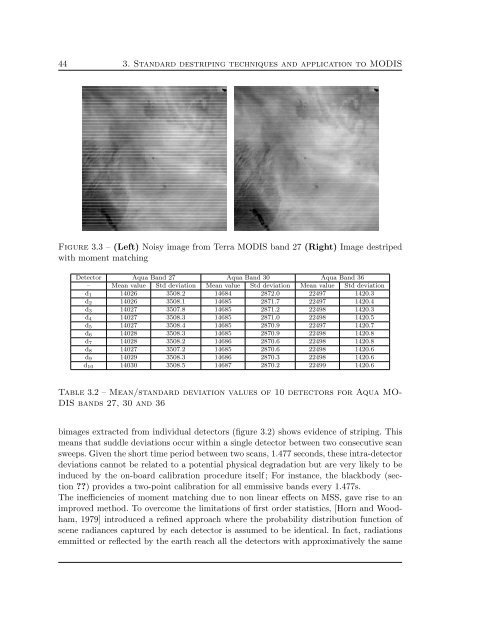Th`ese Marouan BOUALI - Sites personnels de TELECOM ParisTech
Th`ese Marouan BOUALI - Sites personnels de TELECOM ParisTech
Th`ese Marouan BOUALI - Sites personnels de TELECOM ParisTech
Create successful ePaper yourself
Turn your PDF publications into a flip-book with our unique Google optimized e-Paper software.
44 3. Standard <strong>de</strong>striping techniques and application to MODIS<br />
Figure 3.3 – (Left) Noisy image from Terra MODIS band 27 (Right) Image <strong>de</strong>striped<br />
with moment matching<br />
Detector Aqua Band 27 Aqua Band 30 Aqua Band 36<br />
– Mean value Std <strong>de</strong>viation Mean value Std <strong>de</strong>viation Mean value Std <strong>de</strong>viation<br />
d 1 14026 3508.2 14684 2872.0 22497 1420.3<br />
d 2 14026 3508.1 14685 2871.7 22497 1420.4<br />
d 3 14027 3507.8 14685 2871.2 22498 1420.3<br />
d 4 14027 3508.3 14685 2871.0 22498 1420.5<br />
d 5 14027 3508.4 14685 2870.9 22497 1420.7<br />
d 6 14028 3508.3 14685 2870.9 22498 1420.8<br />
d 7 14028 3508.2 14686 2870.6 22498 1420.8<br />
d 8 14027 3507.2 14685 2870.6 22498 1420.6<br />
d 9 14029 3508.3 14686 2870.3 22498 1420.6<br />
d 10 14030 3508.5 14687 2870.2 22499 1420.6<br />
Table 3.2 – Mean/standard <strong>de</strong>viation values of 10 <strong>de</strong>tectors for Aqua MO-<br />
DIS bands 27, 30 and 36<br />
bimages extracted from individual <strong>de</strong>tectors (figure 3.2) shows evi<strong>de</strong>nce of striping. This<br />
means that suddle <strong>de</strong>viations occur within a single <strong>de</strong>tector between two consecutive scan<br />
sweeps. Given the short time period between two scans, 1.477 seconds, these intra-<strong>de</strong>tector<br />
<strong>de</strong>viations cannot be related to a potential physical <strong>de</strong>gradation but are very likely to be<br />
induced by the on-board calibration procedure itself ; For instance, the blackbody (section<br />
) provi<strong>de</strong>s a two-point calibration for all emmissive bands every 1.477s.<br />
The inefficiencies of moment matching due to non linear effects on MSS, gave rise to an<br />
improved method. To overcome the limitations of first or<strong>de</strong>r statistics, [Horn and Woodham,<br />
1979] introduced a refined approach where the probability distribution function of<br />
scene radiances captured by each <strong>de</strong>tector is assumed to be i<strong>de</strong>ntical. In fact, radiations<br />
emmitted or reflected by the earth reach all the <strong>de</strong>tectors with approximatively the same















